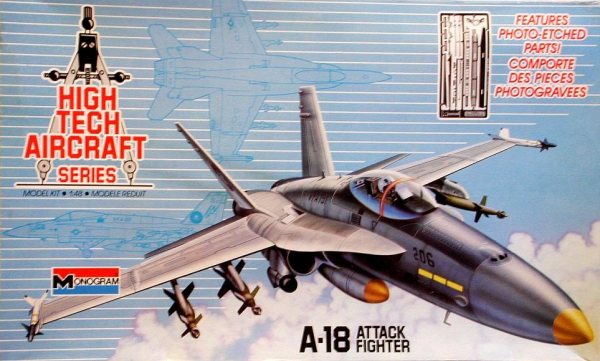
|
KIT: |
Monogram 1/48 F-18 Hornet |
|
KIT # |
5833 |
|
PRICE: |
$12.00 (1987) |
|
DECALS: |
One aircraft |
|
REVIEW: |
|
|
NOTES: |
'Hi Tech' version |

|
HISTORY |
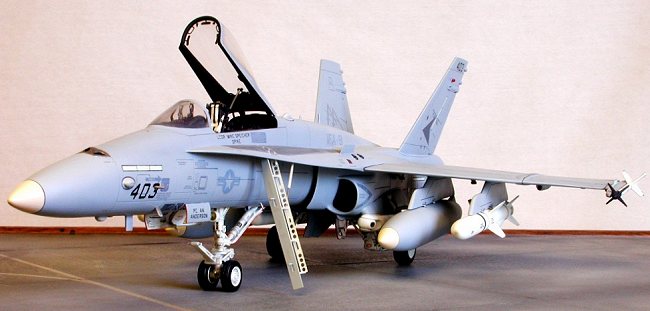
The McDonnell-Douglas F/A-18 Hornet owes its existence to the USAF’s lightweight fighter competition held in the mid-1970s. The winning contender was the General Dynamics YF-16 prototype, which would result in one of the largest military aircraft programs in history. The loser was the Northrop YF-17 Cobra, which might have ended up as a mere footnote in aviation history if not for an unprecedented amount of political and corporate maneuvering.
To understand the genesis of the Hornet some background is necessary. Jack Northrop was not regarded as one of the Defense Department’s favorite sons. His company had pioneered some innovative designs but he was a maverick in every sense of the word, deliberately cranky and cantankerous. His unconventional approach to solving complex aerodynamic problems was never really appreciated by the Pentagon.
The P-61 Black Widow put Northrop on the map during the Second World War while its F-89 Scorpion helped usher the U.S. Air Force into the all-turbine age. The B-49 Flying Wing should’ve been the jewel in Jack Northrop’s crown. Instead it became his Waterloo, when he crossed swords with the-Secretary of the Air Force Stuart Symington over terms of production and profit margin on this revolutionary aircraft.
Powerful political forces were in play here and ultimately, Jack, with few friends in this arena or in the Pentagon, drew a losing hand. The B-49 was unceremoniously cancelled and all the extant airframes were cruelly destroyed on the ramp in full view of Northrop’s demoralized workforce. Symington then arrogantly announced that the new bomber contract would instead be awarded to Convair (in which he himself was a major shareholder!) for the B-36.
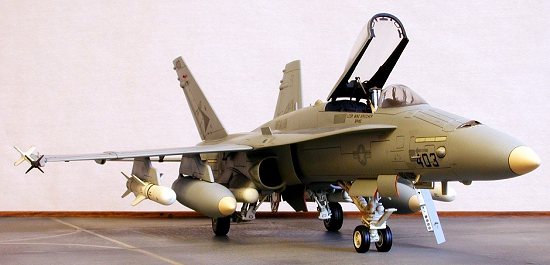 Subsequently, Jack
Northrop became a pariah personified and was never allowed to play any reindeer
games. Planned supersonic follow-ons to the F-89 never materialized and the
entire Century Series era passed without his imprimatur on any combat
aircraft. The Air Force, due to Congressional pressure from the California
delegation, tossed Northrop a bone with the SM-62 Snark missile, but deliberate
malfeasance and partisanship within the service itself transformed this
promising program into a disastrous debacle.
Subsequently, Jack
Northrop became a pariah personified and was never allowed to play any reindeer
games. Planned supersonic follow-ons to the F-89 never materialized and the
entire Century Series era passed without his imprimatur on any combat
aircraft. The Air Force, due to Congressional pressure from the California
delegation, tossed Northrop a bone with the SM-62 Snark missile, but deliberate
malfeasance and partisanship within the service itself transformed this
promising program into a disastrous debacle.
Concurrently, Northrop’s engineering staff were quietly designing a supersonic trainer to meet Air Force requirements for a T-33 replacement. Conventional in layout, inexpensive to buy and maintain, and easy to fly, the aircraft became the T-38 Talon. Grudgingly impressed, service officials reluctantly ordered this plane into production and Northrop’s stock among the aerospace industry and corporate shareholders took a major redemptive leap forward.
During this period in the Cold War, the U.S. Government sought to provide its allies with a low-cost alternative to the expensive and complex Century Series fighter planes then currently in use. The ink had hardly dried on the resultant RFP as Northrop responded with a single-seat proposal based on the T-38. The truth is, Jack (true to his iconoclastic orthodoxy) had designed this aircraft first then adapted it to satisfy the previous trainer requirement.
Northrop faced little opposition and with his new-found political capital, found smooth sailing as thousands of F-5 Freedom Fighters were purchased and furnished world-wide under the U.S. Government’s Foreign Military Sales (FMS) and Military Assistance Program (MAP). The F-5 re-established Northrop as a major aerospace player but in a wry twist, proved a tough act to follow.
Here the tale becomes Ludlum-esque. In the early 1970s Northrop and Lockheed both began research into ‘low observables’ (stealth) technology at the behest of the DOD’s Defense Advanced Research Projects Agency (DARPA). Lockheed, with some previous experience in this field, concentrated on a tactical aircraft while Northrop was nudged toward more strategic applications.
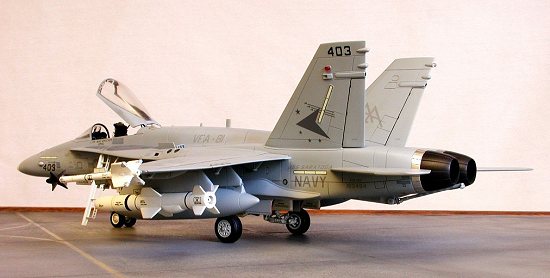 The Northrop engineers
would eventually arrive at the B-2 Spirit but with the previous Flying
Wing fiasco still a major factor in the corporate zeit geist, they
shrewdly retained total propriety over the entire design to include the
classified RAM technology. However, nearly a decade would pass before the
company would demonstrate a prototype and (hopefully) begin profitable
production. A worldwide glut of lightweight fighter planes and looming cash-flow
problems compounded their immediate problem.
The Northrop engineers
would eventually arrive at the B-2 Spirit but with the previous Flying
Wing fiasco still a major factor in the corporate zeit geist, they
shrewdly retained total propriety over the entire design to include the
classified RAM technology. However, nearly a decade would pass before the
company would demonstrate a prototype and (hopefully) begin profitable
production. A worldwide glut of lightweight fighter planes and looming cash-flow
problems compounded their immediate problem.
Following the end of the war in Vietnam and apparent stabilization in the Middle East, it was a buyer’s market for tactical aircraft and intense competition from Dassault’s Mirage III and V, BAC’s Jaguar, Russia’s MiG-21, Fiat’s G-91 and Lockheed’s Starfighter did little to brighten the picture at Northrop. Clearly, a major contract award would be needed to maintain the fiscal viability of the company. Fast forward to 1975…
The Air Force’s new replacement for the venerable F-4, the F-15A Eagle, is just entering the inventory. It’s everything the service wanted. It’s big, it’s fast, it’s maneuverable, it’s lethal. And it’s very expensive. Pentagon planners, ever conscious of dwindling defense dollars in the post-Vietnam era, ordered the Air Force to look for a cheaper alternative that would complement the Eagle and provide a ‘swing’ capability as the F-15 was not yet envisioned as an interdiction and strike aircraft.
This new aircraft would have to be capable of performing the air-to-air and air-to-ground mission simultaneously and coincidentally, and be compatible with every extant and projected type of ordnance in the Air Force inventory (including special stores). Ease of maintenance and low operating costs were stressed in an effort to hold expenditures to acceptable levels. While not specifically mandated, the USAF’s interests would best be served by using an engine already in production, thus economizing on R & D costs previously amortized.
 The service issued an
industry-wide RFP and while several companies expressed interest, the proposals
from General Dynamics (nee Convair) and Northrop were the only ones to receive
any serious consideration (shades of a B-36/B-49 rematch!). The GD design
offered a number of possibilities and used the same P & W F-100 power plant as
the F-15, while the Northrop P-530 Cobra though intriguing was considered
a bit ethereal in comparison. Following a competitive fly-off at Edwards AFB,
General Dynamics was declared the winner and awarded a development and
engineering contract. The NorthropYF-17, as it came to be designated, was
trucked away in the dead of night, ostensibly destined for oblivion while its
design team returned to Palmdale to commiserate privately over their loss to
arch-enemy General Dynamics.
The service issued an
industry-wide RFP and while several companies expressed interest, the proposals
from General Dynamics (nee Convair) and Northrop were the only ones to receive
any serious consideration (shades of a B-36/B-49 rematch!). The GD design
offered a number of possibilities and used the same P & W F-100 power plant as
the F-15, while the Northrop P-530 Cobra though intriguing was considered
a bit ethereal in comparison. Following a competitive fly-off at Edwards AFB,
General Dynamics was declared the winner and awarded a development and
engineering contract. The NorthropYF-17, as it came to be designated, was
trucked away in the dead of night, ostensibly destined for oblivion while its
design team returned to Palmdale to commiserate privately over their loss to
arch-enemy General Dynamics.
Meanwhile, deep within the bowels of the Pentagon, the Navy’s Fighter Mafia, who had never forgiven BuAer’s decision to purchase the two-seat, no guns, McDonnell-Douglas F-4 and put their beloved Crusaders out to pasture, began to beat the drums for a ‘swing fighter’ of their own. That the F-14 could easily perform this dual-role mission did not matter a wit, as the cabal considered the Tomcat as just another huge, fat ‘two-men-in-a-tub’ target as well.
Intense lobbying by the fighter mafia, egged on by allies in Congress forced the Navy to examine the ‘swing fighter’ concept. Naval aviators, who had attended the YF-16/YF-17 fly-off at Edwards, gleefully reminded BuAer that a potential candidate already existed in the Northrop P-530 and would doubtless reduce R & D costs substantially. BuAer eventually acquiesced and the YF-17 was given a fresh look from a Naval perspective.
The original design was substantially enlarged and modified to the point that little of the P-530 remained. To facilitate shipboard operations the landing gear was reconfigured with dual nose wheels up front and strengthened and revamped units at the rear. Folding outer wing panels and an arresting hook were added to complete the basic navalization. A multi-mode radar with an advanced fire control system was envisioned to give the aircraft BVR capability with AIM-7 Sparrow missiles as well as an all-weather strike and interdiction potential.
The General Electric YJ-101 power plants which had powered the YF-17 had never really performed well and, in fact, may have been responsible for the Cobra’s defeat during the fly-off. A new engine based on the hot-core section of the F-101 which powered the B-1 was developed and designated the F-404. It promised better fuel economy and throttle response, with increased thrust overall in military power only and in afterburner. Enlarged and re-configured intake ducts were required to accommodate the new engine’s increased potential.
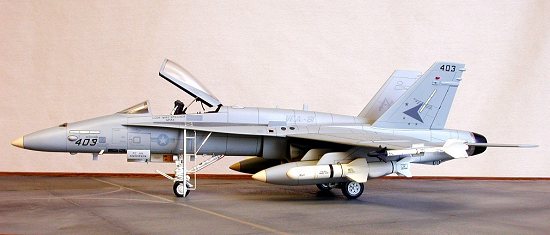 Ultimately, most of the
Cobra concept was left on the cutting room floor as Northrop’s engineering and
design staff massaged the design to fulfill the Naval specifications. Reflecting
still more political skullduggery, the Navy decreed that Northrop must partner
with a company familiar with the service’s unique requirements, as Northrop had
no practical experience with shipboard aircraft. Enter McDonnell-Douglas….Bwahahaha!
Needless to say, the fighter mafia and Northrop were outraged.
Ultimately, most of the
Cobra concept was left on the cutting room floor as Northrop’s engineering and
design staff massaged the design to fulfill the Naval specifications. Reflecting
still more political skullduggery, the Navy decreed that Northrop must partner
with a company familiar with the service’s unique requirements, as Northrop had
no practical experience with shipboard aircraft. Enter McDonnell-Douglas….Bwahahaha!
Needless to say, the fighter mafia and Northrop were outraged.
The goliath from St. Louis greedily gobbled up the lion’s share of manufacturing the newly-designated F/A-18 Hornet, leaving Northrop to produce a mere forty percent of its own airplane! Profit potential was reduced accordingly as well and shareholders were not happy campers. Cancellation of Northrop’s fledgling F-20 Tigershark would come very close to putting the company into receivership, and only a massive infusion of sorely needed R & D money by the incoming Reagan administration for the B-2 project prevented a total financial meltdown. Ultimately, Northrop would wash its hands of the Hornet, bitterly accepting its subordinate role as a mere subcontractor.
As the F/A-18 began flight testing many items were modified or deleted altogether. The ‘dog tooth’, present on the outer wing panels and stabilators was removed to eliminate pitch and roll control problems. The slots in the LEXs were found to generate sufficient parasitic drag to increase the specific fuel consumption to unacceptable levels so they were filled progressively filled until little of the slot remained. Original specifications called for AIM-7 Sparrow missile capability but software problems with the fire control system resulted in a temporary tabling of this requirement.
In adhering to the ‘swing fighter’ concept the Navy intended to replace it’s F-4 and A-7 aircraft with the Hornet. The only problem was, the plane had neither the range nor the payload capability of the Phantom or the Corsair II. This necessitated a reformulation of tactical doctrine to account for the diminished performance while fleet units were forced to embark more tanker aircraft shipboard.
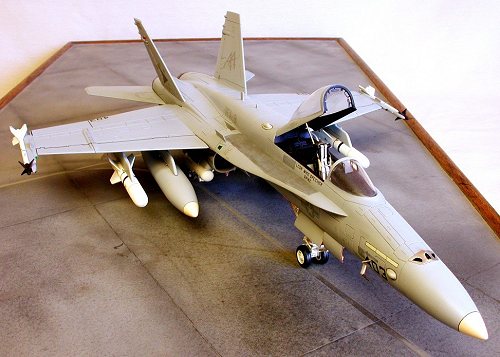 Be that as it may, the
Hornet was placed into production with the first F/A-18s assigned to VFA-125 in
1981 at NAS Lemoore near Coalinga, California. The Marine Corps was in on the
act by this time, fully cognizant of the fighter mafia’s intent to rid both
services of the aging F-4. Their mission requirements added close air support to
the Hornet’s repertoire, with new avionics and software provided to support this
tasking.
Be that as it may, the
Hornet was placed into production with the first F/A-18s assigned to VFA-125 in
1981 at NAS Lemoore near Coalinga, California. The Marine Corps was in on the
act by this time, fully cognizant of the fighter mafia’s intent to rid both
services of the aging F-4. Their mission requirements added close air support to
the Hornet’s repertoire, with new avionics and software provided to support this
tasking.
The Hornet’s baptism of fire occurred in the spring of 1986 during the air strikes against Libyan air defense assets over a right of passage dispute in the Gulf of Sidra. Shortly thereafter, they flew MIGCAP and SAM suppression sorties in support of Air Force F-111s involved with Operation El Dorado Canyon, a strike package designed to avenge Colonel Khaddafi’s terrorist activities in West Germany. From most accounts the Hornets performed well though the short-legged nature of the aircraft continued to pose problems with tactical planners as they juggled mission profiles and available tanker assets.
The F/A-18A was superceded on the production line by an improved ‘C’ model, which featured upgraded avionics and software, several different navigation and targeting sensor pods, plus capability for the new AIM-120 AMRAAM missile. F/A-18Cs served with both Navy and Marine units during the Gulf War, where they scored their first air-to-air kills. Here again, range was a critical consideration though adequate land-based tanker support from Air Force KC-135s and KC-10s prevented any winchester disasters.
McDonnell-Douglas has produced Hornets under the terms of the FMS/MAP programs for sale to numerous allied nations including Australia, Canada, and Spain though only the latter employs them shipboard. The aircraft’s appeal is undoubtedly due to the insurance the F/A-18’s twin-engined layout affords, especially while operating over desolate arctic areas or open seas.
Hornets will continue to serve in fleet and Marine squadrons for the foreseeable future, and the Navy’s ultimate intention is to replace the Grumman F-14 Tomcat with it (though to this author, that issue will forever remain in doubt). In an ironic quirk of fate, Northrop has recently merged with Grumman Aerospace and now has a vested interest in the F-14’s continued service, with its hijacked YF-17 progeny seemingly a whimsical pretender to the Navy throne.
|
THE KIT |
Monogram’s F/A-18 Hornet kit contains ninety-two pieces molded in neutral gray, five transparent parts, and a photo-etched fret of stainless steel items made by Model Technologies. The fold-out instruction pamphlet provides an assembly sequence, a generic painting guide, and a brief history of the aircraft. The decal sheet offers one scheme; BuNo 162900, an F/A-18A assigned to VFA-151 aboard the USS Midway.
The model is broken down horizontally with upper and lower fuselage components while the wings are molded integral with these parts. The separate intake ducts feature individual BLC plates though the ducts themselves are rather shallow. The radome is a separate piece as are the six external hinges for the flaps and ailerons. Gear wells are molded into the lower fuselage half and really look the part after painting and detailing. Surface detail consists of raised panel lines, engraved hinge areas for the movable control surfaces, and recessed vents, louvers, and scoops.
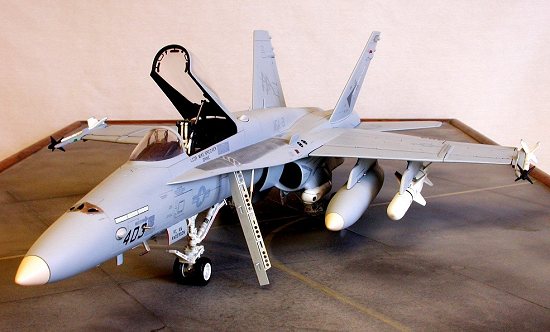 The cockpit is
particularly well depicted with yoke, throttle, and a four-piece seat. Side
console and instrument panel detail is outstanding with all switches, knobs, and
MFDs in easily paintable raised relief. The canopy may be posed open or closed,
while Monogram’s standard-issue seated pilot figure completes the ensemble.
The cockpit is
particularly well depicted with yoke, throttle, and a four-piece seat. Side
console and instrument panel detail is outstanding with all switches, knobs, and
MFDs in easily paintable raised relief. The canopy may be posed open or closed,
while Monogram’s standard-issue seated pilot figure completes the ensemble.
The complex undercarriage is correctly addressed though the nose strut is handicapped by a one-piece molding that oversimplifies many details. The treaded tires are properly sized while the wheel hubs are accurately portrayed. A notable caveat is the arresting hook; the claw is, for reasons unknown, reversed. A simple modification will correct this.
The stabilators are inter-connected by a spindle which is intended to be trapped between the fuselage halves prior to gluing. This spindle has been fractured on literally every Monogram Hornet kit I have examined with the part still attached to the sprue. A replacement, made from steel wire or brass tubing, is recommended.
Further aft, the tailpipes are two-piece affairs which will resemble the business end of a GE F404 turbofan after painting. The separate speed brake may be attached in the retracted or deployed position, supported by a detailed actuator. The vertical fins scale out a bit short and will require some modification to accurately represent a production Hornet.
External stores consist of a 330-gallon fuel tank molded integral with a centerline pylon, navigation and targeting pods attached to the fuselage Sparrow missile mounts, a pair of AIM-9L Sidewinders for the wingtips, and four laser-guided bombs to hang from the wing pylons. These weapons are not certified for carriage by the F/A-18 and the pylons to which they attach are totally bogus.
The clear parts are typical Monogram quality; slightly thick but highly polished. The canopy mounts to a separate frame, which may prove problematic for some modelers. Clear fairings are provided for the fin-mounted anti-collision beacons, while the remaining bit is a heads-up display which will be supplanted by a photo-etched part.
These photo-etched pieces include detail items for the canopy, a boarding ladder, a set of shoulder restraints for the ejection seat, and the aforementioned HUD. This set of parts will go a long way in animating the model, though the instruction sheet is somewhat ambiguous regarding their use. No mention is made of removing the plastic area under the portside LEX, necessary to install the assembled ladder.
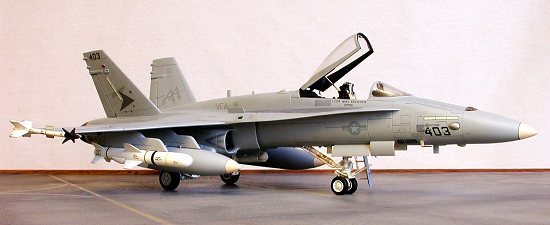 The decals are Monogram’s
de rigueur laughingstock. Minimal stenciling is provided along with
incorrectly colored slime lights and lackluster artwork elsewhere. As
inexpensive as this kit retails for, modelers would do well to consider
purchasing an aftermarket sheet. Nearly every decal company offers at least one
dedicated Hornet release, offering a plethora of marking options to the builder.
The decals are Monogram’s
de rigueur laughingstock. Minimal stenciling is provided along with
incorrectly colored slime lights and lackluster artwork elsewhere. As
inexpensive as this kit retails for, modelers would do well to consider
purchasing an aftermarket sheet. Nearly every decal company offers at least one
dedicated Hornet release, offering a plethora of marking options to the builder.
Addendum
This kit has been released at least four times in different guises. Originally, the model was introduced as an FSD Hornet, white overall with contrasting blue and gold trim. The LEXs were slotted and the wing and stabilators featured the leading edge ‘dog tooth’. An instrumented test boom was included for the nose, along with four Sparrow missiles to mount to the fuselage and wing pylons. The styrene was white.
Next, it was slightly re-tooled to approximate a production ‘A’ model, and available with and without the photo-etched pieces. The decal for the ‘non high-tech’ version offered markings for VFA-125, with ‘NAVY’ on one side of the aircraft and ‘MARINES’ on the other. These kits were molded in gray.
Blue Angels decals and a change to blue plastic followed the standard F/A-18A model. The ordnance was deleted, save for the centerline tank and Sidewinder missiles. The standard Sparrow missile fairings were included. Limited numbers of this release included a promotional Blue Angels embroidered patch.
Monogram’s current incarnation of this model features re-tooled sprues to reflect an F/A-18C. The wing pylons are now correct, the vertical fins have the requisite number of lumps and bumps, the ordnance has been corrected and now mounts on proper vertical ejector racks, while antennas and sensors seems accurate. Decals for this version feature the flamboyant "Chippy Ho" aircraft.
For purposes of construction all of these kits assemble in an identical fashion, with only minor external detail differences. Painting and decaling will, of course, vary between the issues, along with any additional modifications or detailing the modeler may wish to pursue.
|
CONSTRUCTION |
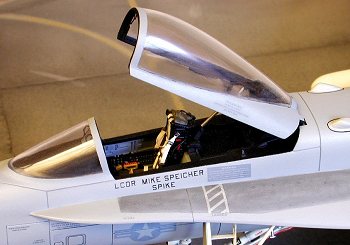 Assembly proceeded
conventionally following the recommended steps in the instruction sheet though I
deviated in a few key areas. I used the OOP Model Technologies’ photo-etched
cockpit set to add additional detail to the sidewalls and avionics bay behind
the seat. The interior parts were assembled, painted, then attached to the
underside of the upper fuselage. The kit seat was assembled and detailed as
well, but I delayed its installation until the model was otherwise complete.
Assembly proceeded
conventionally following the recommended steps in the instruction sheet though I
deviated in a few key areas. I used the OOP Model Technologies’ photo-etched
cockpit set to add additional detail to the sidewalls and avionics bay behind
the seat. The interior parts were assembled, painted, then attached to the
underside of the upper fuselage. The kit seat was assembled and detailed as
well, but I delayed its installation until the model was otherwise complete.
The various scoops and vents were drilled out and baffled to prevent ‘see-through’, then I used photo-etched grills from an OOP Trimaster set for the details present on the prototype. Oil drain tubes under the rear fuselage were replicated by short bits of hypodermic needle. Position lights were installed in the appropriate locations using colored Lexan, then I removed the ladder well area under the portside LEX.
The intakes were affixed next and after I had filled and sanded them flush to the lower fuselage, I rebuilt the chaff/flare dispensers, using pieces from the Trimaster set. The arresting hook was rebuilt using aluminum tubing and steel wire. The incorrect claw was removed from the original part and re-attached in the proper configuration. Hydraulic reservoir gauges were added to the rear fuselage behind sight glass windows made from clear sprue with some spare instrument decals applied to the inside.
After attaching all the main gear doors I added some actuators made from hypo needles and chrome-plated straight pins. The small LEX fences were addressed with .010" aluminum sheet, pre-shaped and installed through slots cut into the top of the fuselage. The dual sensor pods, with their integral Sparrow missile fairing mounts, were detailed, assembled, then glued to the lower fuselage.
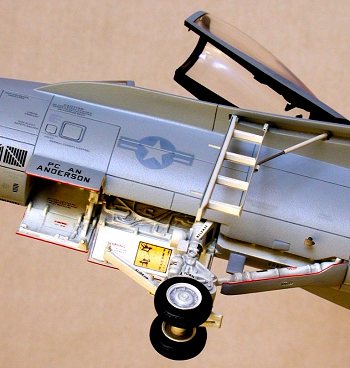 The fuselage was then
assembled, with repeated filling and sanding over several evenings required to
achieve an acceptable fit. Huge gaps between the upper and lower wing were just
as aggravating, and I think I used an entire tube of Crazy Glue on this
procedure. The speed brake was glued on in the closed position then I installed
a bearing in the rear fuselage to mount a new spindle for the stabilators. 3/32"
aluminum tubing was used here, with 1/16" steel wire for the spindle.
The fuselage was then
assembled, with repeated filling and sanding over several evenings required to
achieve an acceptable fit. Huge gaps between the upper and lower wing were just
as aggravating, and I think I used an entire tube of Crazy Glue on this
procedure. The speed brake was glued on in the closed position then I installed
a bearing in the rear fuselage to mount a new spindle for the stabilators. 3/32"
aluminum tubing was used here, with 1/16" steel wire for the spindle.
After drilling a hole in each stabilator, I press-fit them to their new mounts and moved forward. For insurance I added some lead ballast to the radome then glued it on. The teardrop antenna fairings on the nose had been lost during seam clean-up so I built new ones from sprue and attached them with Testors liquid cement. The fairings behind the cockpit were made from modified bullet deflectors from the Monogram B-25 kit.
The vertical fins were modified and detailed then installed. An adjustment was required to both mounting tabs in order to align them correctly. The Sidewinder rails were updated with slime light panels, then glued to the wingtips. With the basic airframe assembled, I sanded off the remaining raised surface detail and rescribed the entire airplane. After cutting the new panel lines I attached the external flap and aileron hinges using Testors liquid cement.
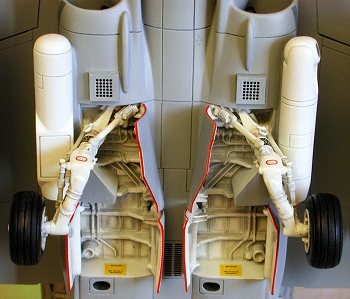 New pitot tubes, AOA
transducers, and a temperature probe made from metal replaced the fragile
plastic pieces. The kit has the outside temperature probe located on the wrong
side of the nose gear well so this was corrected. Opposite, I added the small
intake vent for the forward avionics bay using a piece of 1/16" square brass
channel, beveled at the front. After replacement of the under-scale blade
antennas with new ones fabricated from Evergreen sheet I moved to the landing
gear.
New pitot tubes, AOA
transducers, and a temperature probe made from metal replaced the fragile
plastic pieces. The kit has the outside temperature probe located on the wrong
side of the nose gear well so this was corrected. Opposite, I added the small
intake vent for the forward avionics bay using a piece of 1/16" square brass
channel, beveled at the front. After replacement of the under-scale blade
antennas with new ones fabricated from Evergreen sheet I moved to the landing
gear.
After cleaning up and assembling the wheels I cut new tread grooves in all four tires with an X-acto knife. The main gear struts were built then tacked into position, again using Testors liquid cement. A substantial amount of play between the mounting tabs and their slots required a healthy dose of fiddling until they looked right. Crazy Glue was used to permanently affix them, and after attaching the remaining doors I turned to the nose gear.
This strut looked terrible so I cut away all the molded actuating arms,
re-contoured the underlying structure and added new pieces fabricated from bits
of hypodermic needle and .013" guitar string. Monogram omitted the landing/taxi
light and carrier approach lights so I scratch-built them and attached both to
the top of the strut. An MV lens replicated the
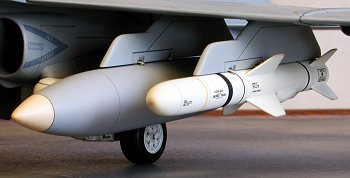 landing/taxi light. The doors and actuators
were glued on then I moved to the wing pylons and ordnance.
landing/taxi light. The doors and actuators
were glued on then I moved to the wing pylons and ordnance.
The kit’s pylons are hopeless so I built new ones using a set liberated from
Monogram’s A-7 kit as a starting point. After roughing them in I built sway
braces for each and decided on a load-out. A second fuel tank was procured, and
after removing the integral centerline pylon, I mounted both to the inboard
stations. AGM-84s, pirated from the Revell A-6E, were modified and installed
outboard while the kit’s Sidewinders were assembled and used at the wingtips.
All ordnance was 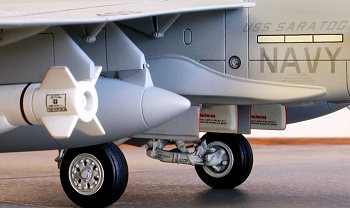 fitted with
a pair of steel wire mounting pins and after a few test-fits to the pylons, the
pylons were rescribed and glued under the wings.
fitted with
a pair of steel wire mounting pins and after a few test-fits to the pylons, the
pylons were rescribed and glued under the wings.
After attaching the photo-etched HUD I added clear acetate for the refracting
glass then installed the windscreen. I rebuilt the canopy actuator with brass
wire and a hypodermic needle then mated the canopy to the frame. The remaining
photo-etched bits were bent and folded into shape then attached with tiny drops
of CA. Next I assembled the tailpipes and dry-fitted them at the rear. After
shaving the openings flat they seemed to fit properly so I set them aside for
final installation after painting and decaling.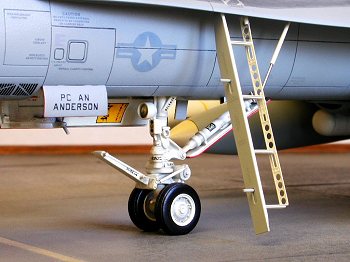
Finally I attacked the piece de resistance of the photo-etched parts, the boarding ladder. This was the most aggravating aspect of the whole model. The left rail is intended to be folded longitudinally into a ‘C’ shape, and after wrangling and agonizing over this part for a couple of nights I DXed it and substituted a ‘C’ section of Plastruct beam. This had a lot more substance to it and assembly proceeded more smoothly. The photo-etched actuating strut and support was replaced using a straight pin and a short piece of #20 hypo needle.
After checking the fit of the ordnance, tailpipes, and ladder I gave the model a final light sanding and inspected all the seams. Everything looked solid so I re-polished the glass and lights then rolled the Bug into the paint shop.
|
PAINT & DECALS |
The first order of business was to paint the undercarriage and gear wells with gloss white. While this dried I applied Bare Metal foil to the stainless steel areas of the muzzle brake and rear fuselage. Returning to the landing gear, I detailed the areas with some stenciling decals from the spares box. After sealing with Testors Dullcote I dusted powdered graphite onto everything to highlight all the recessed details. Red decal stripe was used to edge all the doors (always a pain with Naval aircraft). The wheels were painted and attached then it was time for the main event.
The current TPS scheme was sprayed on using Modelmaster enamels. The kit instruction sheet is conspicuously vague regarding the exterior colors—no information is given at all, so an alternate reference source will be necessary. Radome tan was used on the nosecone cap and drop tank fronts while Gull Gray was brush-painted on the nose and fuselage antenna fairings. As the model dried I painted the missiles and the ladder then set them aside.
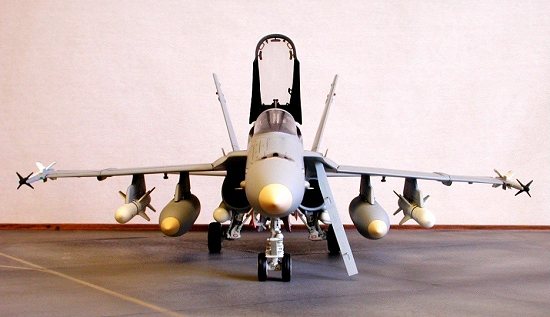 After priming with
Testors Glosscote I applied all the decals, using the OOP RepliScale "Gulf War
Mig Killers" sheet. Service stencils came from the SuperScale data set,
supplemented by bits and pieces from the Testors/Italieri kit’s decal. Slime
lights are from ScaleMaster’s sheet while the wing walks were depicted using
dark gull gray solid decal and cut to shape by means of a template. In an
unprecedented departure (for me), I was compelled to use the ladder location
indicator from the Monogram kit sheet, as it needed to be light gray and all the
other items at my disposal were dark gray. Nonetheless, it laid down adequately
over the portside wing walk with minimum fuss.
After priming with
Testors Glosscote I applied all the decals, using the OOP RepliScale "Gulf War
Mig Killers" sheet. Service stencils came from the SuperScale data set,
supplemented by bits and pieces from the Testors/Italieri kit’s decal. Slime
lights are from ScaleMaster’s sheet while the wing walks were depicted using
dark gull gray solid decal and cut to shape by means of a template. In an
unprecedented departure (for me), I was compelled to use the ladder location
indicator from the Monogram kit sheet, as it needed to be light gray and all the
other items at my disposal were dark gray. Nonetheless, it laid down adequately
over the portside wing walk with minimum fuss.
After sealing the decals with Dullcote I used Liquitex watercolor to highlight the gun gas purge louvers, the movable control surfaces, and the exhaust ducts on the bottom of the fuselage. An HB draftsman’s pencil was used for the wingfold hinge lines, while powdered graphite was dusted over the wing walks to grunge them up a bit. After a final shot of Dullcote I glued the seat into the cockpit and attached the canopy. The tailpipes were sprayed flat black and burnished on the exterior with powdered graphite. After buffing with a Q-Tip I installed them then glued the ladder into position.
The ordnance was decaled, again using spares box orphans, then press-fitted into position on the pylons. Likewise the stabilators were installed, then I used Testors lacquer thinner and a #1 sable hair brush to remove overspray from the pitot tubes, AOA transducers, the temperature probe, and the foiled areas. A three-wire trap in my display case and the Hornet was complete.
|
CONCLUSIONS |
As Monogram kits go, the F/A-18 is about average. Poor fit will hamper the assembly though the cockpit, landing gear, and overall lines provide pleasing relief. While this model cannot be accused of shake-and-bake status accorded to the Hasegawa Hornet, neither does it command the outrageous $50+ retail price.
An extensive effort will be necessary if a serious Hornet is to be realized from this kit and I would not recommend it to novice modelers or the faint of heart. Any takers should be familiar and comfortable with filler and sandpaper. Modelers should also be prepared to deal with severe warpage between major airframe components.
My observations aside, this model can build up nicely. I haven’t yet had the opportunity to A-B this effort next to a build-up of Hasegawa’s wunderkit but it looks the part of a Hornet to me. I just wouldn’t be in any huge ball-crushing rush to build another one anytime too soon. So many kits, so little time…
|
REFERENCES |
F/A-18: In Detail & Scale – Bert Kinzey; Airlife Publishing LTD
Modern Military Aircraft: Hornet – Lou Drendel; Squadron-Signal Publishing
F/A-18 Hornet In Action – Lou Drendel; Squadron-Signal Publishing
Hornet: Aeroguide #20 – Roger Chesneau; Linewrights LTD
Stingers: The McDonnell-Douglas F/A-18 – Bill Gunston; Mallard Press
The Cutting Edge – C.J. Heatley III; Thomasson, Grant, and Howell Publishing
Marine Air: First To Fight – John Trotti and George Hall; Presidio Press
Strike: US Naval Strike Warfare Center – John Joss and George Hall; Presidio Press
CV: Carrier Aviation – Peter Garrison and George Hall; Presidio Press
Top Gun: The Navy’s Fighter Weapons School – George Hall; Presidio Press
Ó November 2001 by Roger M. Jackson
If you would like your product reviewed fairly and quickly by a site that has thousands of visits a day, please contact me or see other details in the Note to Contributors.